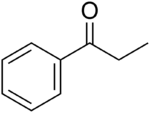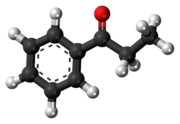Propiophenone
 | |
 | |
| Names | |
|---|---|
| IUPAC name
1-Phenylpropan-1-one | |
| Other names
Ethyl phenyl ketone, BzEt | |
| Identifiers | |
| 93-55-0 | |
| 3D model (Jmol) | Interactive image |
| ChEBI | CHEBI:425902 |
| ChEMBL | ChEMBL193446 |
| ChemSpider | 6881 |
| ECHA InfoCard | 100.002.053 |
| PubChem | 7148 |
| UNII | E599A8OKQH |
| |
| |
| Properties | |
| C9H10O | |
| Molar mass | 134.18 g·mol−1 |
| Appearance | Colorless liquid |
| Density | 1.0087 g/mL |
| Melting point | 18.6 °C (65.5 °F; 291.8 K) |
| Boiling point | 218 °C (424 °F; 491 K) |
| Insoluble | |
| Related compounds | |
| Related ketones |
Acetophenone Butyrophenone |
| Except where otherwise noted, data are given for materials in their standard state (at 25 °C [77 °F], 100 kPa). | |
| | |
| Infobox references | |
Propiophenone (shorthand: benzoylethane or BzEt) is an aryl ketone. It is a colorless, sweet-smelling liquid that is insoluble in water, but miscible with organic solvents. It is used in the preparation of other compounds.
Production
Propiophenone can be prepared by Friedel–Crafts reaction of propionic acid and benzene. It is also prepared commercially by ketonization of benzoic acid and propionic acid over calcium acetate and alumina at 450–550 °C:[1]
- C6H5CO2H + CH3CH2CO2H → C6H5C(O)CH2CH3 + CO2 + H2O
Ludwig Claisen discovered that α-methoxystyrene forms this compound when heated for an hour at 300 °C (65% yield).[2][3]
Uses
It is an intermediate in the synthesis of pharmaceuticals and organic compounds.[4][5] It can also be used in the synthesis of aryl alkenes, such as phenylpropanoids. With a flowery odor, propiophenone is a component in some perfumes.
Uses
It is an intermediate in the synthesis of pharmaceuticals and organic compounds.[6][7] It can also be used in the synthesis of aryl alkenes, such as phenylpropanoids. With a flowery odor, propiophenone is a component in some perfumes.
Propiophenone can be used in the synthesis of a variety of pharmaceutical drugs:
- Stimulants: PPA, ephedrine, cathinone, methcathinone, metamfepramone, amfepramone, phenmetrazine.
- Cathinone analogs of fenfluramine & tiflorex in EP 0007843A1.
- Analgesia: dextropropoxyphene, pyrroliphene, etoxadrol,
- Antitussive/bronchial: diphepanol, eprazinone,
- Red links: oxifenamate, flumecinol, iminophenimide, and bencisteine.
Not propiophenone proper, but based on this core structure:
- Muscle Relaxants: Inaperisone, Tolperisone.
- Synthetic nonsteroidal estrogen: paroxypropione
- PAPP (Poison)
References
- ↑ Siegel, H.; Eggersdorfer, M. (2005), "Ketones", Ullmann's Encyclopedia of Industrial Chemistry, Weinheim: Wiley-VCH, doi:10.1002/14356007.a15_077
- ↑ Claisen, Ludwig (1896). "Ueber eine eigenthümliche Umlagerung" [On a peculiar rearrangement]. Berichte der deutschen chemischen Gesellschaft. 29 (3): 2931–2933. doi:10.1002/cber.189602903102.
- ↑ Spielman, M. A.; Mortenson, C. W. (1940). "The Condensation of α-Methoxystyrene with Halogen Compounds". Journal of the American Chemical Society. 62 (6): 1609–1610. doi:10.1021/ja01863a076.
- ↑ "propiophenone". Merriam-Webster.com. Merriam-Webster. Retrieved 2 June 2012.
- ↑ Hartung, Walter H.; Crossley, Frank (1936). "Isonitrosopropiophenone". Org. Synth. 16: 44. doi:10.15227/orgsyn.016.0044.; Coll. Vol., 2, p. 363
- ↑ "propiophenone". Merriam-Webster.com. Merriam-Webster. Retrieved 2 June 2012.
- ↑ Hartung, Walter H.; Crossley, Frank (1936). "Isonitrosopropiophenone". Org. Synth. 16: 44. doi:10.15227/orgsyn.016.0044.; Coll. Vol., 2, p. 363